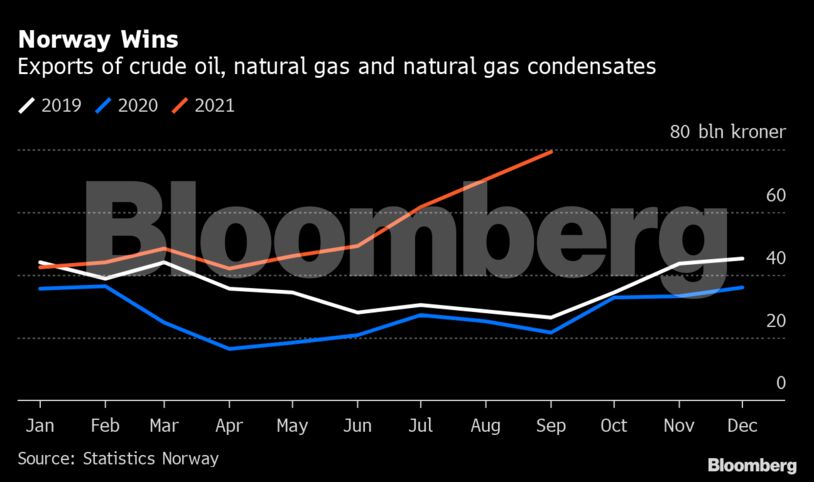Norway, with huge oil and gas fields, saw exports hit an all-time high for a third straight month in September, with natural gas sales jumping seven-fold from a year earlier. The bounty is the result of both a bounce in energy demand after pandemic restrictions were eased, coupled with a surge in prices.
The country, which accounts for 25% of European Union natural gas imports, is reaping the financial benefits of a crisis that’s squeezed households and businesses across much of the region, forcing governments to promise aid to help with bills.
State-owned Equinor ASA, which publishes third-quarter results Wednesday, is set to be a winner of the energy crisis. Of the energy giant’s total production, about 35% is gas sold in Europe. Net income was probably $2.3 billion, more than six times the year-earlier figure.
The flood of cash — higher than had been anticipated — is setting Norway apart from other countries worried about bloated debt levels in the wake of stimulus spending during Covid lockdowns. It means the state can cut the amount it needs to tap from its sovereign wealth fund, the world’s biggest at $1.4 trillion.
Norway’s new government, formed after elections in mid-September, plans to continue to develop the country’s lucrative oil and gas fields. According to the previous administration, fuel revenue is expected to surge 72% to 184 billion kroner ($18.8 billion) this year, 30 billion kroner higher than estimated at the start of the year. It’s seen hitting 277 billion kroner in 2022.
“There are very high gas prices right now and gas is an important part of our exports,” Norway’s minister for petroleum and energy, Marte Mjos Persen, said in a telephone interview. “We know how important our oil and gas revenues and oil wealth are for welfare development.”
Europe’s supply squeeze may not ease for some time. Gas-storage sites in the EU are at their lowest seasonal level in at least a decade, and the World Bank’s latest Commodity Markets Outlook forecasts that energy prices will remain elevated into 2022.
Norway has benefited more directly from the recent gas price moves than competitors because of its contracts. Producers are more exposed to European hub pricing than Russia or Algeria, whose supplies are still largely linked to oil prices.
“Norway’s market based contract pricing is paying off these days,” said Sindre Knutsson, a gas market analyst at consulting firm Rystad Energy.
Despite the gas squeeze on Europe, Norway is avoiding political damage, unlike Russia, which has faced criticism over the crisis.
So far, Russia hasn’t sent any significant additional volumes to the region’s spot market, citing the need to prioritize filling domestic storage ahead of winter.
Gas deliveries from Norway to the EU have risen by close to 5% in the first nine months of the year, according to Gergely Molnar, an energy analyst at the International Energy Agency.
“Norway is playing a key role in ensuring seasonal supply flexibility,” he said.
Domestically, the country is insulated from the gas-price surge, as more than 90% of its power needs are met by domestic hydroelectricity.
It has the “unusual double-edged benefit of being a major gas producer, so benefiting from high prices, yet a very small gas consumer,” said Andrew Hill, head of European gas analysis at BloombergNEF.
However, it’s having its own crisis thanks to a water shortage that’s hit the hydro industry and sent power prices higher.
Read More: Norsk Hydro Becomes a Net Power Buyer
The government is looking for solutions “for those who struggle the most,” said Persen. That could mean some of the extra revenue flowing in from exports gets directed toward aid for households.
“Those who worry should not be alone with those worries,” she said. “But this is also an important reminder that our power generation system is very weather dependent and it is strongly affected by the conditions in our neighboring countries.”
Share This:




 CDN NEWS |
CDN NEWS |  US NEWS
US NEWS 





























